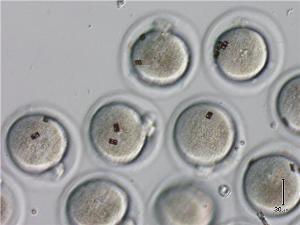Nov 20 2010
Researchers from the Department of Cell Biology, Physiology and Immunology at Universitat Autònoma de Barcelona (UAB), in collaboration with researchers from the Institute of Microelectronics of Barcelona (IMB-CNM) of the Spanish National Research Council (CSIC), have developed an identification system for oocytes and embryos in which each can be individually tagged using silicon barcodes.
Researchers are now working to perfect the system and soon will test it with human oocytes and embryos.
 Researchers insert identification codes into mouse embryos
Researchers insert identification codes into mouse embryos
The research, published online in Human Reproduction, represents a first step towards designing a direct labelling system of oocytes and embryos. The objective was to develop a system which minimises risks when identifying female gametes and embryos during in vitro fertilisation and embryo transfer procedures, to reduce the phases of the clinical process requiring control and supervision by two embryologists.
Microscopic silicon codes, fabricated using microelectronic techniques, were employed in the research. In previous tests, researchers verified the innocuousness of silicon particles in human cells, particularly in macrophages. In the present study, the codes were microinjected into the perivitelline space of mouse embryos, located between the cell membrane and the zona pellucida, a cover which surrounds the plasma membrane of the embryo. Since the embryo exits the zona pellucida before its implantation in the uterus, this approximation should allow the embryo to free itself of the identification codes when leaving the zona pellucida.
This research shows that labelled embryos develop normally in culture up to the blastocyst stage, the phase of development which precedes implantation. Researchers also studied the retention of the codes throughout the culture process, the easiness in reading the codes in a standard microscope, and their elimination when embryos free themselves from the zona pellucida. The research also verified the efficacy of the system when freezing and thawing the embryos.
To make the system more viable, researchers are now working on improving the embryo's process of freeing itself from the identification code. This is the only stage of the research which presented limitations. They are currently studying whether the modification of the codes' surface could allow their direct attachment to the outer side of the zona pellucida, avoiding their microinjection into the perivitelline space. They also aim to develop an automatic code reading system.
Researchers recently received authorisation from the Department of Health of the Government of Catalonia to begin testing the system with human oocytes and embryos from several fertility clinics in Spain.
The research was carried out with the participation of Elena Ibáñez, Sergi Novo, Leonardo Barrios, Josep Santaló and Carme Nogués from the UAB Department of Cell Biology, Physiology and Immunology; and Rodrigo Gómez-Martínez, Marta Duch, Jaume Esteve and José Antonio Plaza from the Institute of Microelectronics of Barcelona, a CSIC member centre, at the UAB Research Park.
Source: http://www.uab.es/